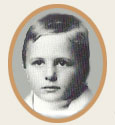by guest author M.E.
Editor’s note: I am actually the third generation of my family to believe that nutritional deficiencies play a major role in health problems and that anyone with knowledge of the scientific method can treat him/herself. Here our guest writer and 2nd-gen orthomolecular self-experimenter M.E. — aka Mom — presents a brief bio of my grandfather.
When vitamins weren’t even a thing yet
Back in 1909, a very excited five-year old boy was given a ride in the first automobile in his small Midwestern town. Little Jimmy grew up to be an engineer and remembered this “horseless carriage” in detail for the rest of his long life. He also remembered that the car’s owner, the town doctor, told him that day about a new discovery that would bring many benefits to mankind, including cures for disease. The discovery came to be called “vitamins.”
An Adelle Davis fan is born
Starting in the late 1940s a series of books on nutrition by Adelle Davis, who unusually for a woman in her day had an M.S. in chemistry, were extremely popular with the public, while being severely criticized by many of her fellow nutritionists. Jimmy, by this time called Jim, remembered what “Doc” had said about vitamins and began reading Davis’ books. Although a number of her ideas did prove harmful in practice, many others were well ahead of their time, including her warnings about the dangers of vitamin deficiencies, hydrogenated fat, saturated fat, and excess sugar consumption, and about the need for exercise.
Retirement: a Linus Pauling fan is born
Later, retired and suffering from ill health, Jim continued his readings in nutrition and health and discovered the work of Linus Pauling, whose work in chemistry had earned him the Nobel Prize in Chemistry in 1954. He also won the Nobel Prize for Peace in 1963, for his indefatigable efforts which helped bring about the Partial Nuclear Test-Ban Treaty that year. He is the only person to have won two undivided Nobel Prizes.
One of Pauling’s areas of interest was the role of molecules in the human body. His research included numerous breakthroughs in what he came to call “orthomolecular” medicine. In 1970 Pauling published Vitamin C and the Common Cold, a bestseller which (shades of Adelle Davis) attracted heavy criticism from the medical field. Nobel prizes aside, Pauling soon became best known for promoting the use of massive doses of vitamin C to cure many ailments. So although he was and is widely recognized as one of the greatest scientists of the 20th Century, and by some as the greatest chemist in history, in the 1970s Dr. Pauling had many detractors who dismissed him as a quack. And some still do.
But Jim found Dr. Pauling’s research compelling and often quoted Pauling’s concept that humans are not biologically identical. In addition to lots of vitamin C, by the mid-1970s Jim’s daily regimen included numerous different supplements, in addition to a daily exercise regimen and what even today would be considered an extremely healthy diet. More important, he had returned to excellent health.
Editor’s note: When he was in his mid-80s, his wife confided to me that she had tried to get him to wear cologne because all the supplements he took made him smell “a bit yeasty.”
Diving deep into alternative medicine
He started traveling throughout the Southwest to meet with physicians who were also interested in alternative approaches. (Some of these turned out to be, in his words, “real quacks.”) He also toured the facilities of the manufacturers and distributors of supplements he was considering (and noted sub-standard manufacturing and/or handling practices in at least one). At some point in the 1980s he began buying all his supplements in powder form to avoid ingesting too much filler material.
In his research he had as an accomplice his much-younger primary care physician, who often tracked down reports and studies at his request. The doctor probably did not agree with all the information he forwarded to Jim, but seemed to enjoy his unconventional role. And he could not argue with the effects on Jim’s health.
92 vibrant years
In their 80s, Jim and his friends formed an octogenarian golf league. At 92 he happily played all nine holes in their annual spring tournament. Then, six weeks later, a recently-detected defective heart valve ended his vibrant life.
In his latter decades, Jim frequently remarked that his regimen, most notably all the supplements, had added at least 25 years of good health to his life.
Ignoring naysayers can pay off!
When this content was published or posted
This content was first published in December 2011 and updated in March 2023.






Hello,
nice blog you have here, I’ve read all the entries, lots of interesting stuff.
Fyi,
you cannot count “warning against saturated fats” as being ahead of time. Saturated fats are highly beneficial.
I’d say that even eating refined sugar is not dangerous unless it displaces your vitamin and mineral intake and/or makes you eat more calories than you burn.